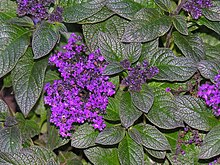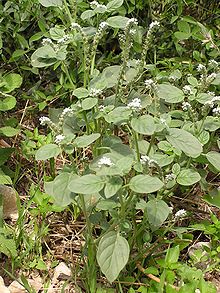Heliotropium
| Heliotropium | |
|---|---|

| |
| Heliotropium arborescens | |
| Scientific classification | |
| Kingdom: | Plantae |
| Clade: | Tracheophytes |
| Clade: | Angiosperms |
| Clade: | Eudicots |
| Clade: | Asterids |
| Order: | Boraginales |
| Family: | Boraginaceae |
| Subfamily: | Heliotropioideae |
| Genus: | Heliotropium L. |
| Type species | |
| Heliotropium europaeum L. [1]
| |
| Species | |
|
250-300, see text | |
| Synonyms | |
|
Beruniella Zakirov & Nabiev | |
Heliotropium /ˌhiːliəˈtroʊpiəm, -lioʊ-/[3] is a genus of flowering plants in the borage family, Boraginaceae. There are around 325 species in this almost cosmopolitan genus,[4] which are commonly known as heliotropes (sg. /ˈhiːli.ətroʊp/[clarification needed]). It is highly toxic for dogs and cats.
Etymology[]
The name "heliotrope" derives from the old idea that the inflorescences of these plants turned their rows of flowers to the sun.[5] Ἥλιος (helios) is Greek for "sun", τρέπειν (trepein) means "to turn". The Middle English name "turnsole" has the same meaning.
A Classical myth, told in Ovid's Metamorphoses, imagines that the water nymph Clytie, in love with the sun god Helios, was betrayed by him. Wasting away, she transformed into the heliotrope, whose flowers supposedly always face the sun.
Ecology and human use[]

Several heliotropes are popular garden plants, most notably garden heliotrope (H. arborescens). Some species are weeds, and many are hepatotoxic if eaten in large quantities due to abundant pyrrolizidine alkaloids. There have been cases of canine death due to over-ingestion of this toxic plant.[6][7] Some danaine butterflies, such as male queen butterflies, visit these plants, being attracted to their pyrrolizidine alkaloids.[8] Though it is not palatable and most animals will completely ignore it, there have been cases of horses, swine and cattle being poisoned due to contamination of hay.[9]
Caterpillars of the grass jewel (Freyeria trochylus), a gossamer-winged butterfly, feed on .[citation needed]
The sap of heliotrope flowers, namely of European heliotrope (H. europaeum), was used as a food coloring in Middle Ages and Early Modern French cuisine.[citation needed]
One of the most famous ragtime piano melodies is "Heliotrope Bouquet", composed in 1907 by Louis Chauvin (the first two strains) and Scott Joplin (the last two strains).
Garden heliotrope is grown in Southern Europe as an ingredient for perfume.[10]
The purplish facial rash of dermatomyositis is called "heliotrope rash" because it resembles E. arborescens.[11]
Heliotrine and Heliotridine[]
This section needs expansion. You can help by . (February 2021) |
Seeds of the Heliotropium species were discovered in the 1940s and 50s to be responsible for liver disease in populations that consumed them in large quantities, either inadvertently (as a contaminant of food crops) or deliberately (associated with the ingestion of herbal infusions for the treatment of certain ailments). The seeds contained high concentrations of pyrrolizidine alkaloids, identified mainly as the N-oxide of heliotrine (74%), and one or two other compounds similar in character to lasiocarpine. [12]
Taxonomy[]
Taxonomic revision supported through molecular phylogenetics led to the recognition of Euploca as genus separate from Heliotropium.[13][4] In contrast, the genus Tournefortia was included in Heliotropium in a 2016 revision.[4]
Within Heliotropium, there are four major clades:[4]
- Heliotropium sect. Heliothamnus I.M.Johnst.
- Old World Heliotropium clade
- Heliotropium sect. Cochranea (Miers) Post & Kuntze
- Tournefortia clade, comprising Tournefortia sect. Tournefortia and all remaining New World Heliotropium species
Selected species[]



- Heliotropium amplexicaule Vahl – clasping heliotrope, summer heliotrope, blue heliotrope
- Heliotropium anderssonii
- Heliotropium anomalum Hook. & Arn. – Polynesian heliotrope, Pacific heliotrope (Pacific Islands)
- Heliotropium anomalum var. argenteum – hinahina kū kahakai (Hawaii)
- Heliotropium arborescens – garden heliotrope, common heliotrope, cherry pie
- Heliotropium argenteum
- R.Br.
- Heliotropium balfourii
- R.Br.
- F.Muell. ex Benth.
- F.Muell. ex Benth.
- F.Muell. ex Benth.
- (A.DC.) Clos.
- DC.
- Heliotropium curassavicum L. – seaside heliotrope, salt heliotrope, monkey tail, quail plant, Chinese parsley; cola de mico (Spanish)
- Heliotropium dentatum
- Heliotropium derafontense
- F.Muell. ex Benth.
- Heliotropium europaeum L. – European heliotrope, European turnsole (Europe, Asia, and North Africa)
- R.Br.
- F.Muell. ex A.S.Mitch.
- Heliotropium foertherianum & – tree heliotrope, velvet soldierbush, octopus bush (South Asia, East Asia, Melanesia, western Polynesia, northern Australia)
- R.Br.
- R.Br.
- (F.Muell.) Ewart & O.B.Davies
- Heliotropium indicum L. – Indian turnsole
- Heliotropium kuriense
- Loefg.
- Phil.
- I.M.Johnst.
- Heliotropium nigricans
- R.Br.
- Heliotropium pannifolium – St. Helena heliotrope (Saint Helena) (extinct, c. 1820)
- R.Br.
- Heliotropium paulayanum
- F.Muell.
- R.Br.
- Heliotropium riebeckii
- Heliotropium shoabense
- (Miers) I.M.Johnst.
- Heliotropium socotranum
- Heliotropium stenophyllum
- Willd.
- Heliotropium tenellum
- R.Br.
- Heliotropium wagneri
- Heliotropium aff. wagneri (Samhah, Yemen)
Formerly included here[]
- Chrozophora tinctoria (as H. tricoccum)
- (L.) R.Br. ex Roem. & Schult. (as H. gnaphalodes L.)[14]
See also[]
- Turnsole
- Heliotrope (disambiguation)
References[]
- ^ "Heliotropium L". TROPICOS. Missouri Botanical Garden. Retrieved 2010-01-12.
- ^ "Genus: Heliotropium L". Germplasm Resources Information Network. United States Department of Agriculture. 2006-04-02. Archived from the original on 2009-08-27. Retrieved 2010-01-12.
- ^ Sunset Western Garden Book, 1995:606–607
- ^ Jump up to: a b c d Luebert, F.; Cecchi, L.; Frohlich, M.W.; et al. (2016). "Familial classification of the Boraginales". Taxon. 65 (3): 502–522. doi:10.12705/653.5. ISSN 0040-0262. Retrieved 16 June 2018.
- ^ Chittenden, Fred J. Ed., Royal Horticultural Society Dictionary of Gardening, Oxford 1951
- ^ https://web.archive.org/web/20180217091105/http://www.limerickvet.com/news-info/pet-news/in-remembrance-of-goldie/
- ^ Kakar, Faizullah et al. “An outbreak of hepatic veno-occlusive disease in Western afghanistan associated with exposure to wheat flour contaminated with pyrrolizidine alkaloids.” Journal of toxicology vol. 2010 (2010): 313280. doi:10.1155/2010/313280
- ^ Male sex pheromone of a giant danaine butterfly, Idea leuconoe
- ^ Witherill, Richard. "Heliotrope". PAWS Dog Daycare. Retrieved 27 January 2014.
- ^ Floridata: Heliotropium arborsecens
- ^ http://www.dermnetnz.org/immune/dermatomyositis.html
- ^ (Dubrovinskii, 1947, 1952; Khanin, 1948; Bras et al., 1954, 1961; Bras & Hill, 1956; cited in World Health Organization (1988), PYRROLIZIDINE ALKALOIDS, INTERNATIONAL PROGRAMME ON CHEMICAL SAFETY, ENVIRONMENTAL HEALTH CRITERIA 80.
- ^ Hilger, H.H.; Diane, N. (2003). "A systematic analysis of Heliotropiaceae (Boraginales) based on trnL and ITS1 sequence data". Botanische Jahrbücher. 125 (1): 19–51. doi:10.1127/0006-8152/2003/0125-0019. ISSN 0006-8152.
- ^ "GRIN Species Records of Heliotropium". Germplasm Resources Information Network. United States Department of Agriculture. Archived from the original on 2012-12-11. Retrieved 2010-09-17.
- Everitt, J.H.; Lonard, R.L.; Little, C.R. (2007). Weeds in South Texas and Northern Mexico. Lubbock: Texas Tech University Press. ISBN 978-0-89672-614-7.
External links[]
| Wikimedia Commons has media related to Heliotropium. |
| Wikispecies has information related to Heliotropium. |
- A Heliotrope at Gardener's Path
- Picture of Heliotropium chenopodiaceum at Chileflora
- Heliotropium
- Boraginaceae genera

